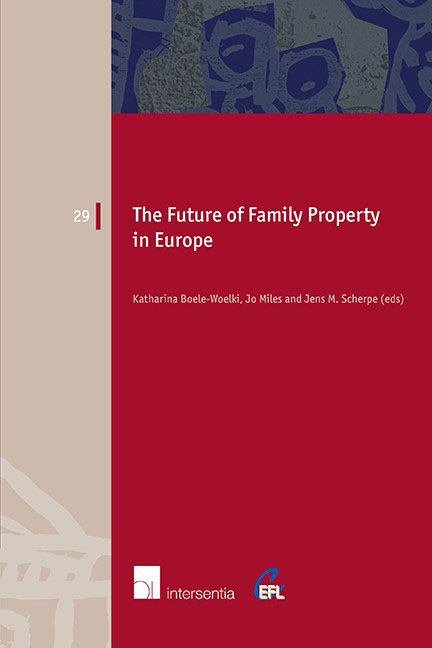Book contents
- Frontmatter
- Preface
- Contents
- List of authors
- PART ONE KEYNOTE LECTURE
- PART TWO MATRIMONIAL PROPERTY LAW IN EU ROPE
- PART THREE FAMILY CONTRACTS – ISSUES OF AUTONOMY
- PART FOUR PROTECTION OF OLDER PEOPLE IN LAW
- PART FIVE FREEDOM OF TESTATION AND PROTECTION OF FAMILY MEMBERS
- PART SIX CHILD MAINTENANCE
- PART SEVEN UNIFICATION OF PRIVATE INTERNATIONAL FAMILY LAW
- PART EIGHT CLOSING REMARKS
Matrimonial Property Law in Europe
Published online by Cambridge University Press: 08 May 2020
- Frontmatter
- Preface
- Contents
- List of authors
- PART ONE KEYNOTE LECTURE
- PART TWO MATRIMONIAL PROPERTY LAW IN EU ROPE
- PART THREE FAMILY CONTRACTS – ISSUES OF AUTONOMY
- PART FOUR PROTECTION OF OLDER PEOPLE IN LAW
- PART FIVE FREEDOM OF TESTATION AND PROTECTION OF FAMILY MEMBERS
- PART SIX CHILD MAINTENANCE
- PART SEVEN UNIFICATION OF PRIVATE INTERNATIONAL FAMILY LAW
- PART EIGHT CLOSING REMARKS
Summary
PROPERTY RELATIONS BETWEEN SPOUSES : A DIFFERENCE IN APPROACH BETWEEN CIVIL AND COMMON LAW
Continental European legal systems generally regulate the proprietary consequences of marriage through a specific body of matrimonial property law, rather than leaving them to be governed by general property law rules. While most continental legal systems contain some provisions relating to property in the general law on marriage (régime primaire, allgemeine Ehewirkungen), for example rules governing the family home and household assets, which are binding independently of the matrimonial property regime (régime sécondaire), it is the matrimonial property regime which lies at their core. Spouses enjoy a large degree of autonomy and can choose their preferred matrimonial property regime in a pre-nuptial agreement, the statutory matrimonial property regime serving just as a default rule.
The common law does not have matrimonial property law as understood in the civil law systems, and therefore also does not have a default matrimonial property regime. Since the Married Women's Property Act 1882, marriage has no effect upon the proprietary rights of the parties in England and Wales. As a result, the spouses’ assets remain separate. In contrast to continental law, marital agreements, which in England and Wales could more appropriately be termed separation or divorce agreements, traditionally are not binding. This is comparable to the legal situation in Ireland.
Most continental legal systems draw a clear distinction between matrimonial property and maintenance, whereas common law systems in principle deal with both issues simultaneously.
The function of maintenance will be of lesser importance in systems where the courts have the power to reallocate property. Reallocation of family assets is a particularly important mechanism in common law systems to guarantee the standard of living and equality between the spouses. Maintenance, in the form of financial provision, is mainly granted when property redistribution cannot guarantee the required standard of living. In continental systems reallocation is extremely rare, although a few examples can be found. In some Nordic legal systems the courts have the power of reallocation. The French prestation compensatoire and the Spanish pensión compensatoria are not totally comparable with the common law system of reallocation but combine elements of maintenance and matrimonial property. However, most continental legal systems do not have special provisions regulating the distribution of marital property and where a community system applies, the community is simply divided into equal parts.
- Type
- Chapter
- Information
- The Future of Family Property in Europe , pp. 19 - 46Publisher: IntersentiaPrint publication year: 2011
- 2
- Cited by

